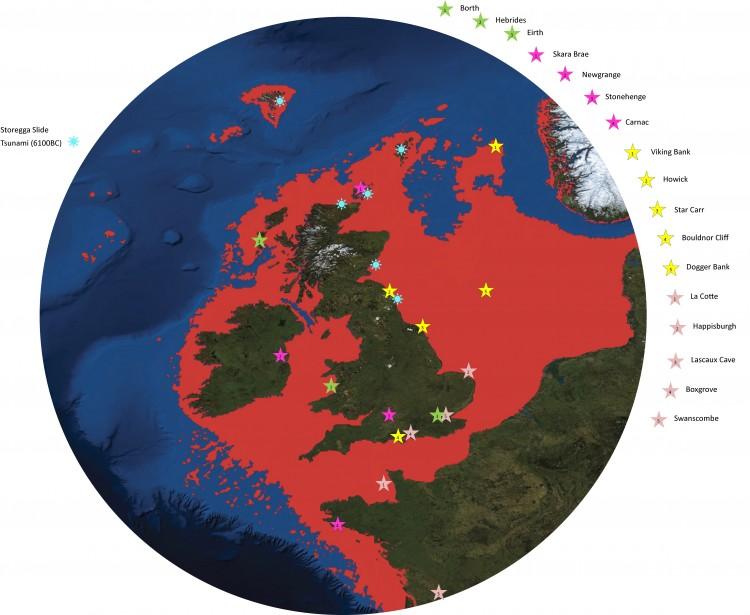Focus
Atlantis
Cantre'r Gwaelod: The (Mythical?) Sunken Kingdom of Wales
The story of Atlantis is not unique to the ancient Greeks, as other cultures also have similar legends of landmasses that disappeared under the waves. One of these is the story of Cantre’r Gwaelod from Wales.
|
Orichalcum: Legendary Metal of Atlantis Found in 2,600-Year-Old Shipwreck
The mysterious metal spoken of in ancient Greece, said to glimmer with a reddish light in Atlantis, may have been found.
|
Britain’s Atlantis, Lyonnesse: The Sunken Land of Arthurian Legend
Off the coast of Cornwall, at the southern tip of the UK, on a clear day, the Isles of Scilly can be seen at some distance. Those islands, some say, are the peaks of a sunken land that was a prosperous kingdom in the days of yore.
|
The Lost Continent of Kumari Kandam
In the subcontinent of India is a tale similar to that of Atlantis, that of the ‘lost continent’ of Lemuria, frequently connected to the legend of Kumari Kandam by speakers of the Tamil language.
|
Atlantis May Have Been in Bolivia?
Bolivia’s famed mirror-like salt flats, Salar de Uyuni, and the neighboring mountain Pampa Auallagas may harbor the fabled lost city of Atlantis, according to author Jim Allen.
|
What Happened to Cuba’s Sunken City?
Just over a decade ago, a team of explorers were working on an exploration and survey mission off the western coast of Cuba when their sonar equipment picked up a perplexing series of stone structures lying some 650 meters below the surface.
|
Doggerland: Atlantis-Like Country Discovered off Scottish Coast
A vast underwater area in the North Sea may once have been home to tens of thousands of Stone Age people before suffering a devastating tsunami and gradually disappearing under rising sea levels.
|
Atlantis Returns to Earth for Last Time Ever (Video)
Space shuttle Atlantis has landed for the 33rd and final time at 5:57 a.m. EDT on July 21 at NASA’s Kennedy Space Center, Florida, marking the retirement of NASA’s 30-year space shuttle program.
|
Lost City of Atlantis on Google Maps?
On the floor of the Atlantic Ocean, about 600 miles off the coast of northwest Africa, near the Canary Islands, lies a mysterious grid that was spotted by an English aeronautical engineer while using Google Earth 5.0 when it came out in 2009.
|
Kennedy Space Center Rolls Out Atlantis
After the successful return of space shuttle Discovery, NASA officials are moving ahead on their next mission, Atlantis.
|
Ancient Submerged Cities: Rethinking Our Ancestry
Marine archeology has been able to flourish, treating the world to some amazing discoveries of our distant past.
|
Cantre'r Gwaelod: The (Mythical?) Sunken Kingdom of Wales
The story of Atlantis is not unique to the ancient Greeks, as other cultures also have similar legends of landmasses that disappeared under the waves. One of these is the story of Cantre’r Gwaelod from Wales.
|
Orichalcum: Legendary Metal of Atlantis Found in 2,600-Year-Old Shipwreck
The mysterious metal spoken of in ancient Greece, said to glimmer with a reddish light in Atlantis, may have been found.
|
Britain’s Atlantis, Lyonnesse: The Sunken Land of Arthurian Legend
Off the coast of Cornwall, at the southern tip of the UK, on a clear day, the Isles of Scilly can be seen at some distance. Those islands, some say, are the peaks of a sunken land that was a prosperous kingdom in the days of yore.
|
The Lost Continent of Kumari Kandam
In the subcontinent of India is a tale similar to that of Atlantis, that of the ‘lost continent’ of Lemuria, frequently connected to the legend of Kumari Kandam by speakers of the Tamil language.
|
Atlantis May Have Been in Bolivia?
Bolivia’s famed mirror-like salt flats, Salar de Uyuni, and the neighboring mountain Pampa Auallagas may harbor the fabled lost city of Atlantis, according to author Jim Allen.
|
What Happened to Cuba’s Sunken City?
Just over a decade ago, a team of explorers were working on an exploration and survey mission off the western coast of Cuba when their sonar equipment picked up a perplexing series of stone structures lying some 650 meters below the surface.
|
Doggerland: Atlantis-Like Country Discovered off Scottish Coast
A vast underwater area in the North Sea may once have been home to tens of thousands of Stone Age people before suffering a devastating tsunami and gradually disappearing under rising sea levels.
|
Atlantis Returns to Earth for Last Time Ever (Video)
Space shuttle Atlantis has landed for the 33rd and final time at 5:57 a.m. EDT on July 21 at NASA’s Kennedy Space Center, Florida, marking the retirement of NASA’s 30-year space shuttle program.
|
Lost City of Atlantis on Google Maps?
On the floor of the Atlantic Ocean, about 600 miles off the coast of northwest Africa, near the Canary Islands, lies a mysterious grid that was spotted by an English aeronautical engineer while using Google Earth 5.0 when it came out in 2009.
|
Kennedy Space Center Rolls Out Atlantis
After the successful return of space shuttle Discovery, NASA officials are moving ahead on their next mission, Atlantis.
|
Ancient Submerged Cities: Rethinking Our Ancestry
Marine archeology has been able to flourish, treating the world to some amazing discoveries of our distant past.
|









